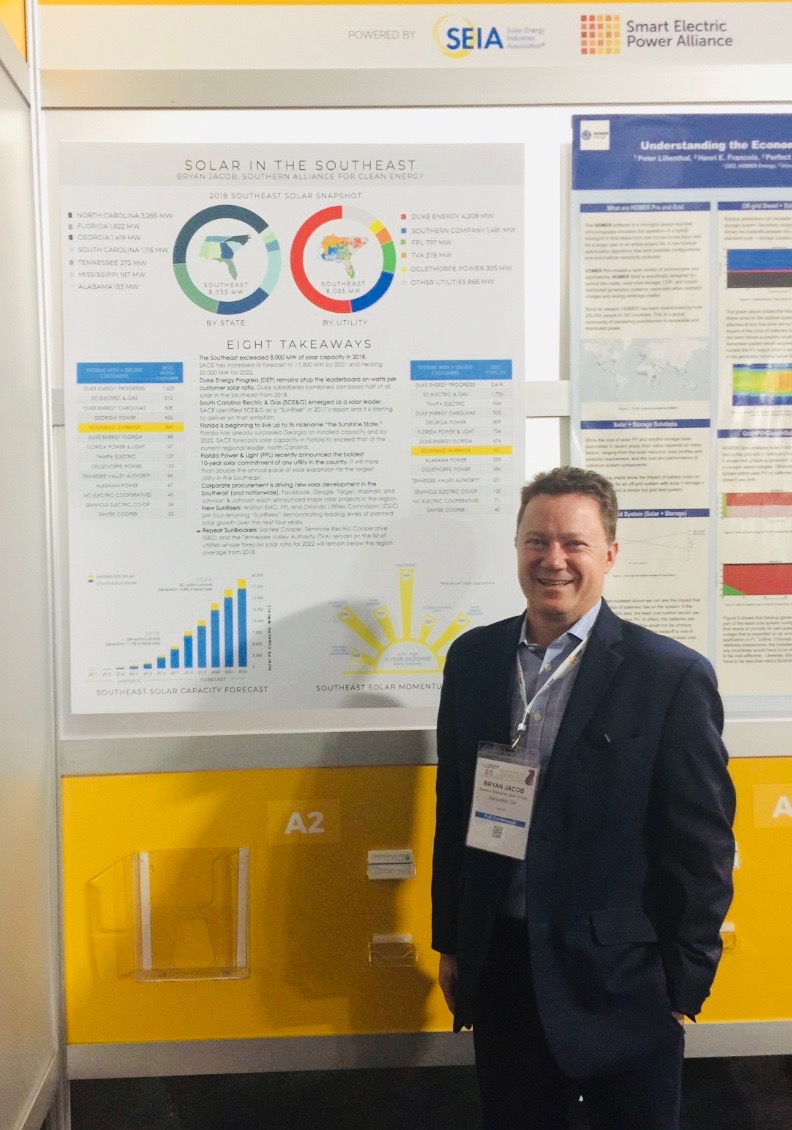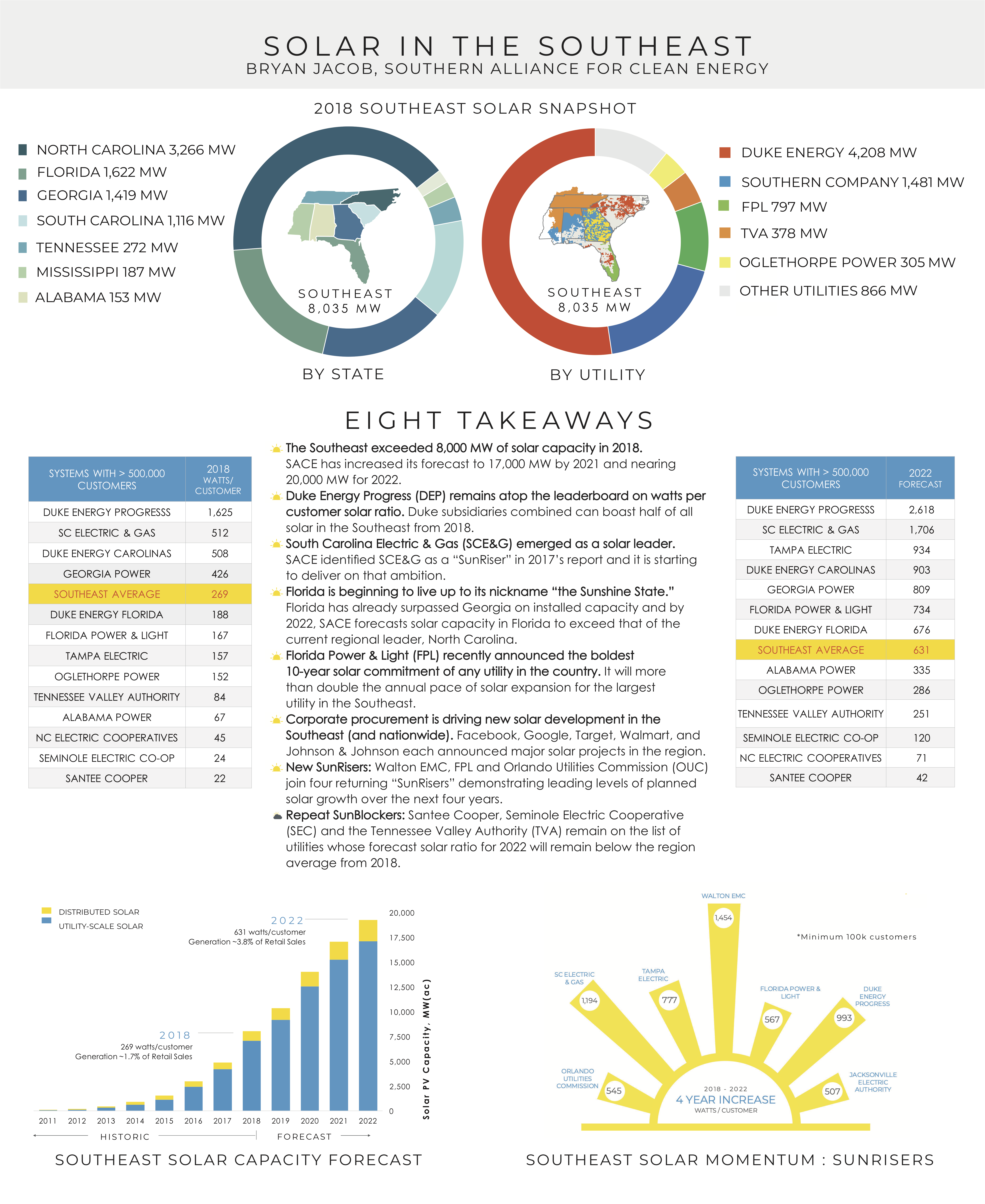Bryan Jacob represented SACE at Solar Power International (SPI) and North America Smart Energy Week along with 19,000 other energy professionals. Following are Bryan's reflections from this annual convening.
Bryan Jacob | September 30, 2019 | Energy Justice, Energy Policy, Solar, Utilities
Every year I look forward to attending the Solar Power International (SPI) conference, the largest energy event in North America. This year’s conference was held in Salt Lake City, Utah where 19,000, attendees, 700+ exhibitors, and 500+ speakers spread across the clean energy spectrum soaked in the latest energy information and policy, and discussed opportunities for collaboration and improvement in the renewable energy industry.
Roadmap to energy grids with more renewable energy
At this years conference, we got a jump start on Solar+ Decade (“solar plus”). Technically, Solar+ refers to the period 2020-2030, but SEIA, the Solar Energy Industries Association, announced the release of a strategic roadmap for fulfilling this ambitious 10-year vision where the U.S. will achieve 20% of electricity generation in 2030 from solar energy. This represents a significant stretch goal because the US presently generates only 2.4% from solar – slightly less in the Southeast (1.7% from 2018 and projected to be around 2.1% for 2019).
Many of the sessions at SPI addressed aspects of the four pillars from this roadmap:
- Aggressive Collaboration (for example, with the wind industry),
- Market Accelerators (like energy storage),
- Market Levers and Policy Drivers (federal climate policy, for example), and
- Managing Growth (including a specific focus on diversity and equity).


Opportunities for industry growth
In addition to meetings and exploring the 11 acre exhibit hall, I also had the chance to participate in various, informative workshops and plenary sessions. Here are a few of my take-aways:
- The solar industry has consistently over-delivered. Twenty years ago, the Energy Information Agency (EIA) had projected the U.S. would get to 2 gigawatts (GW) by 2020. We’re already at 95 GW. This gives me confidence about the Solar+ Decade.
- Solar will prevent more than 360 million metric tons of greenhouse gas emissions (about 1/3 of the energy sector over the 2020-2030 decade. This represents about 20% of the U.S. commitment to the Paris Agreement.
- Moreover, solar will contribute $50 billion annually to the U.S. economy as we achieve the 20% Solar+ Decade objective.
- Distributed solar (e.g., rooftop), in addition to utility-scale solar, will be necessary to fulfill this vision. And proper valuation of distributed solar will be critical. A recent Environment America report about “The True Value of Solar” points out how many value-of-solar studies leave out key benefits of solar energy – especially societal benefits like emission reductions.
- Diverse companies are more efficient and more profitable (evidence here). But the solar industry remains below the U.S. average for key diversity aspects.
- Gender Diversity – 26% Women in solar vs. 47% for the U.S. workforce overall
- Racial Diversity – 8% African Americans in solar vs. 12% for the U.S. workforce overall
- In addition to the profile of the workforce producing solar energy, we also have work to do to ensure equitable access to the benefits of solar for those consuming. Several sessions and a podcast (4:08:00) addressed topics of access to solar for low-moderate income (LMI) households.
- Paula Glover, President of American Association of Blacks in Energy (AABE), spoke on a topic of significant interest to SACE, energy burden. She emphasized that 1 in 3 U.S. households have trouble paying energy bills and 1 in 5 have to decide between medicine, food, rent or utilities – these challenges correlate to race, not geography.
- There was good turnout for a session including South Carolina Senator Tom Davis and North Carolina Representative John Szoka. These two Republican leaders joined a lively panel to discuss “A Tale of Two Carolinas” – comparing and contrasting the Competitive Energy Solutions for NC act and the S.C. Energy Freedom Act.
- Hallway conversations as well as an impromptu session hosted by SEIA’s Katherine Gensler discussed implications of the Public Utility Regulatory Policies Act (PURPA) overhaul recently proposed by the Federal Energy Regulatory Commission (FERC).
- There was limited traffic during the poster reception, but mine included key results and observations from the latest SACE Solar in the Southeast annual report. View the PDF version of the poster here.
Mark your calendars!
Solar Power International will be held in Anaheim again next year: September 14-17, 2020. See you there and until then, continue to follow SACE’s coverage of solar in the Southeast.